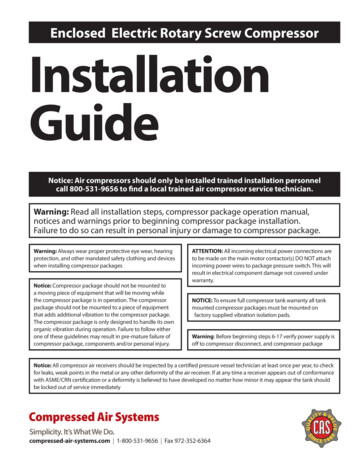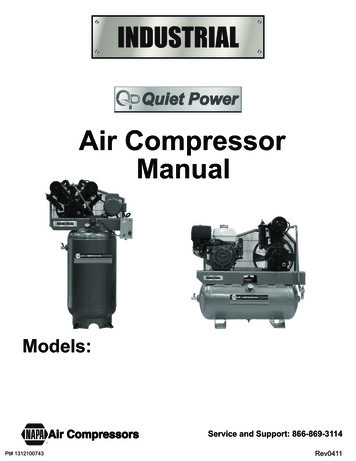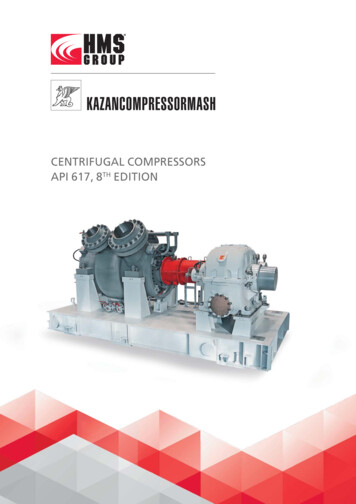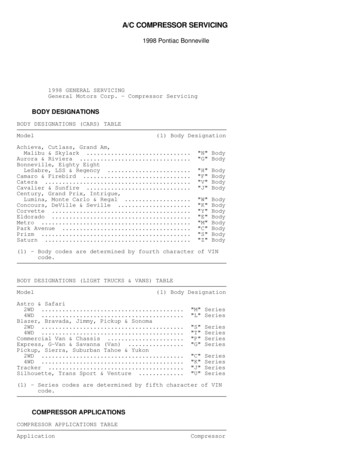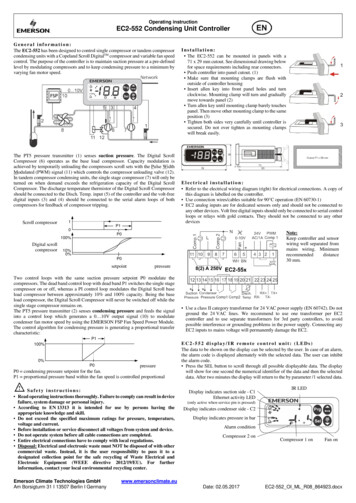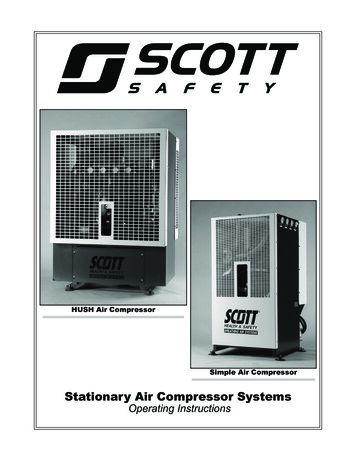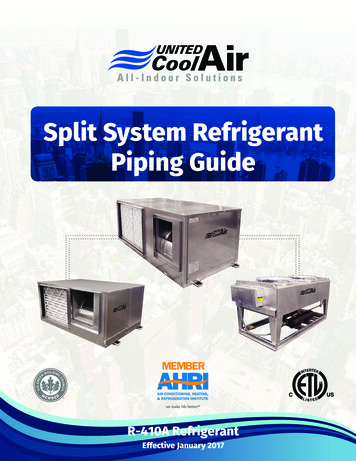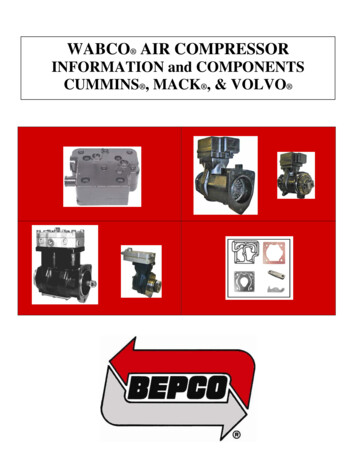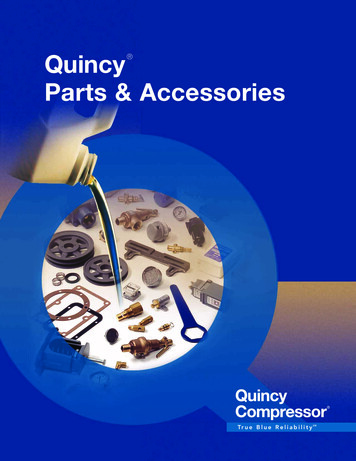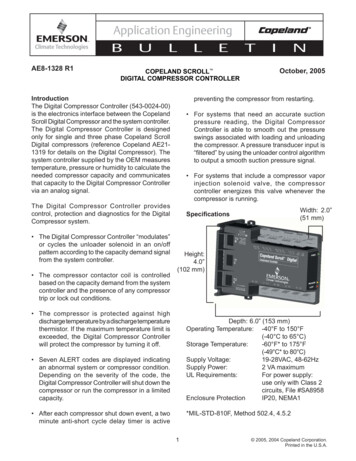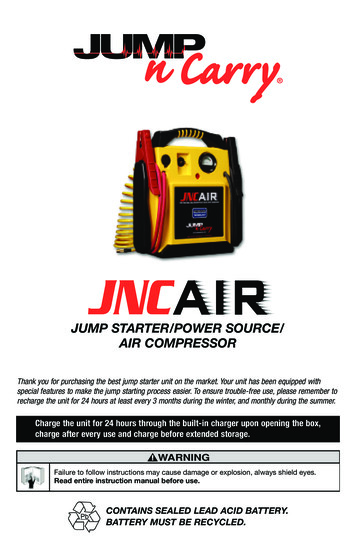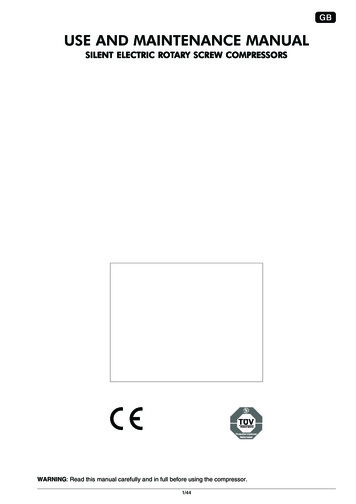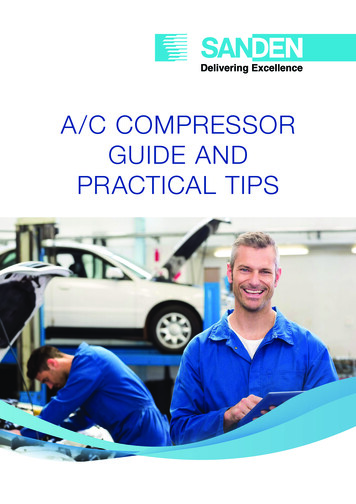
Transcription
A/C COMPRESSORGUIDE ANDPRACTICAL TIPS
1 ABOUT SANDENA /C SYSTEM OVERVIEWABOUT SANDENA/C SYSTEM OVERVIEWFounded in 1943:Sanden was first established asSankyo Electric Company by KaiheiUshikubo as a manufacturer of bicyclelamps, with a distinctive owl trademark.Kaihei UshikuboRefrigeratedshowcase1960s: Vending machineElectric type originalHybrid typeGlobal Centerof TechnologyAs sales figures for refrigeration unitssteadily increased, Sankyo Electricdeveloped another innovation, whichwould later become one of its mostsuccessful ventures – the originalbubble juice vending machine.Bubble juicevending machineFirst generationcompressorScroll typeSanden VendomachineAkagi ForestSwash plate type1990s: Tacklingenvironmental issuesSanden developed open – scrolltype automotive compressors tohelp prevent ozone layer destruction.For these environmentally friendlyservices, Sanden was awarded bythe Agency for Natural Resourcesand Energy.Electric type - Gen1Sanden is committed to reducingglobal footprint, and establishedthe Sanden Global Center ofTechnology in 2008 to continuouslydevelop eco-friendly productsalongside new technologies. In2002, Sanden opened SandenForest, which is now an area ofnatural beauty, and a harmonioussynergy of land development andthe natural environment.Sanden developed their first SwashPlate compressor for improvedpassenger car comfort. To meetemerging market needs, Sandenentered the heavy vehicle market,and developed their first heavy dutyand super heavy duty compressors.Already an automotive market leader,Sanden developed a full electriccompressor for use in passenger car.Sanden became the market leaderfor truck integrated parking coolingand started to supply full HVACassembly to key truck customers.The Future:Electric type Gen2 EvoEvaporatorCompressor2000s: Reducingglobal footprint2010’s: ElectrificationHVAC1980s: Becoming aglobal enterpriseIn 1981, Sanden developed a scrolltype compressor for automotive forthe first time in the world. Sanden alsoacquired Vendo, the second largestvending machine manufacturer in theU.S. Sales and production bases werecreated all over the world, and Sandenbecame a truly global enterprise andindustry leader.Drawing on the successes fromstrategic alliances that paved the wayinto the automotive industry, Sandenbecame known as a key compressorsupplier for major OEMs.2000s: The firstSwash Plate1970s: Automotiveair-conditioningSankyo Electric entered into atechnical alliance with MitchellCorporation, and began producingcompressors for passenger cars in1970, which marked an entranceinto the automotive market. With thisnew industry came a new corporateidentity – Sanden.Low-sideservice port1990s: Automotiveindustry leader1950s: IntroducingrefrigerationSankyo Electric Company enteredthe electric home appliance marketby producing electric washers andmini-motors. Drawing on thesesuccesses, Sankyo Electric producedan open-type refrigeration showcasefor business use, which became thefirst of its kind in the industry.2Sanden celebrated 75 yearsof business in 2018, and looksforward with excitement to thenext 75 years. With passionate andknowledgeable employees andinnovative strategies, Sanden iscommitted to Delivering Excellenceto every customer, every time.High-sideservice portExpansionValve (TXV)CondenserReceiver/DrierA/C common malfunctionsCompressor seizureA/C malfunctions explainedAll compressors designed to run with compressor oil willfail in case of poor oil/refrigerant arrival to the compressor,as the compressor will not be lubricated/refrigerated. Forexample, if an engine is run without oil or coolant, theengine will fail.In the case of PX compressors, the typical seized areawill be the piston shoes and swash plate.During normal compressor operation, the componentsare lubricated with an oil film, which reduces frictionand allows for the dissipation of heat. The compressormoves a mixture of oil and refrigerant through the A/Csystem. This mixture lubricates and refrigerates thecompressor’s internal components that are in movement.The system refrigerant acts as a heat carrier and aids inthe component lubrication and removal of heat from thecomponents. Poor oil lubrication will lead to an increasein the temperature and dilation of the components. As aresult of the dilation, the space around the componentswill be reduced/eliminated, and so the oil film willdisappear. The oil film elimination will create metal-tometal contact and so seizures will occur.Seizures occur as a result of lack of lubrication andcooling. This condition can be caused by the following:For SDH compressors, the commonly seized areasare the central ball and the piston rod sockets. Centerballseizure is an example of a seizure which results when thecompressor and/or centerball is deprived of adequatelubrication and cooling. This failure usually results in thecenterball melting and becoming welded to the fixed gear.*In the case of SDV compressors, the typical seized areawill be the balance ring.* Sanden warranty applies to compressors that have beendiagnosed as having a manufacturing fault.In the case of TR compressors, the typical seized areawill be the central area of the scroll. Lack of refrigerant flow due to inadequate charge. TXV blockage or malfunction. Thermostat failure. No air flow to evaporator (blower fan motor failure). Lack of refrigerant and/or oil due to a leak or oil trap. Lack of return oil due to too long a circuit or systemundercharge. Blockage in system due to contamination in system. Defective centerball or gear mating surface. Liquid slugging due to improper system charging. Charging liquid refrigerant into compressor (washesoff oil film from around the centerball when thecompressor is connected).
3A /C SYSTEM OVERVIEWClutch slippingClutch slipping is a condition that occurs whenthe armature plate fails to engage and rotate insynchronization with the clutch rotor. Clutch slippageoccurs as a result of high torque requirement conditions,very low voltage supply conditions or clutch wearing. Thefield coil when energized becomes an electromagnetwhich then magnetizes the clutch rotor and armatureplate. Friction and magnetic attraction cause thearmature plate and clutch rotor to lock together (clutchengagement) and rotate the compressor shaft.Clutch slipping specifically refers to a situation that occurswhen the armature plate fails to lock together properlywith the rotor. The armature will then tend to drag (slip)against the rotor surface. This dragging (slipping) resultsin intense friction and heat. As the slipping continues,the heat causes deformation of the armature plate. Inthe case of a rubber armature, clutch slipping may leadto melting of the rubber damper and can result in asubsequent failure of the entire clutch mechanism.Possible causes of clutch slipping and overheating: Liquid migration to crankcase when the A/C system is off. Liquid slugging -will cause high shaft rotation torque.This inhibits rotation of the armature plate and leadsto slipping. Contamination on friction surfaces - will diminish thecoefficiency of friction between the two mating surfacesand result in slipping of the armature. Low voltage to the field coil - causes a reduction in theA /C SYSTEM OVERVIEW / TROUBLESHOOTING TIPSCustomer damage includes but is not limited tothe following:in the system can lead to liquid slugging. Liquidslugging is a condition which occurs whenliquid is allowed to enter one or more cylinders.Because liquid is practically non-compressible,the compressor seals may be compromised whenthe pistons attempt to compress the liquid. Liquidslugging can lead to permanent valve damage andreduced compressor efficiency. Compressor ear mount damage occurs from anincorrect gap between the bracket and the ear mountIn some situations, moving the installation bushes tothe recommended position is required prior to fittingthe compressor. Overtorquing of hose fittings which can result inThere are 4 primary identifiers of moisture contamination.1. Contaminated Oil Contaminated oil is identifiedby it’s colour.Clear/yellow oil - new or used oil.Light grey oil - Common within the first fewhours of use.Light green/yellow oil - oil contains a leakdetector additive.Silver/grey oil - indicates the presence of largermetal particles in the oil.Black oil - small metal particles are present in the oil.Brown oil (carbonized oil) - the A/C system hasoverheated due to condenser malfunction, blockageor airflow restriction through the condenser,defective pressure switch or lack of oil/refrigerant.Orange oil (this is applicable only to Sanden oil) the oil has become contaminated by humidity.Moisture contamination occurs as a result ofmoisture being allowed to enter and remain in the A/Csystem. This condition can be caused by the following:stripped threads or broken ports. Improper field service. Parts that are incorrectlyreplaced or installed can result in subsequentcompressor failure. A typical checklist involves:- Receiver drier MUST be replaced every time theA/C system is inspected- A/C flushing in case of oil contamination- Replacing the refrigerant and oil- Expansion valve replacement (if needed)- Any oil leaks must be repaired Mechanical damage to the clutch, scratches, nicks,dents, air gap modified, lead wires pulled out,pinched, cut etc. Improper vacuuming of system. Contaminated system components. Contaminated refrigerant and/or oil. Saturated or malfunctioning drier. Water permeability through the hoses. Leaving uncapped hoses or any A/C components2. Rust Rust may occur on internal steelcompressor components that are exposed tomoisture for extended periods.3. Slugged Valves A slugged valve is one that hasbeen permanently deformed as a result of liquid slugging.4. Copper Plating The presence of copper platinggenerally occurs when there is a high moisturecontent in the A/C system.exposed to the air for long periods of time. Leaving the suction/discharge caps off thecompressor Mechanical damage to the compressor cylinder block. Receiver drier must be replaced according to A/C The addition of non approved chemicals which may4system manufacturer recommended service periodcause system and / or compressor malfunction. Improper packaging or handling of the compressor. Improper modification of the compressor i.e. painting,TROUBLESHOOTING TIPSplating, polishing etc.strength of the magnetic field of the field coil. System overpressure - will cause high shaft rotationtorque. This inhibits rotation of the armature plate andleads to slipping. Engine harness defective connection - may result ininsufficient current being applied to the field coil.Customer damageCustomer damage refers to instances wherecompressor failure is caused by improper installation,mishandling and / or incorrect system application.Compressors are susceptible to damage wheneverfailures occur within the A/C system. System failsafes such as Pressure Relief Valves (PRV), ThermalProtection Switches (TPS) and High / Low pressurecut offs are often used to reduce the possibilityof compressor damage under abnormal systemconditions. These devices limit damage to A/Ccomponents by making the system inoperablewhenever a severely abnormal condition develops.When a returned compressor is analyzed for failureresponsibility, the physical condition of the compressoris examined to determine if the compressor wassubjected to handling damage and/or improperinstallation. If the compressor has external indications,or shows evidence that it was subjected to extremeconditions which caused the failure, then the cause ofthe failure may be determined to be customer damage.Undercharge not enough gas in the systemMoisture contaminationrefers to a failure which results from conditionswhich can occur when moisture is introduced intothe A/C system.1Moisture can create ice at the expansion valve levelwhich can cause erratic functioning of the valve. Asa consequence of this malfunction, liquid refrigerantarrives at the compressor or a low amount of therefrigerant/oil mixture arrives at the compressor.Moisture can also cause corrosion of internal parts,such as the valve plate.During normal compressor operation, the pistonscompress refrigerant gas in the cylinders. MoistureMedium to high compressor dischargetemperature.The reason this happens is because the fluidcoming into the compressor is hot.Part of the function of the suction gas is to cool thecompressor. If the gas enters hotter than normal, itwill also be hotter than normal when it exits.The A/C compressor is designed to perform efficientlyunder specific controlled conditions. If contaminantsare introduced into the system they act to reducecompressor efficiency, effectiveness and durability.Moisture as used in this context refers to water inany form (solid, liquid or gas). When moisture isintroduced in the A/C system, it may combine withthe system refrigerant to form an acidic solutionwhich can erode internal compressor components. Inthis case moisture does not cause direct compressorfailure; the failure results from the failure of a partwhich has been weakened as a result of the effectsof rust and/or corrosion.42High suction superheatThe reason you will have higher superheat isbecause the expansion device will be starvedof liquid due to the undercharging. When theexpansion device is starved, it will pass bothliquid and vapour and will not be able to controlsuperheat. As there is not enough refrigerant in thesystem, all the refrigerant arriving at the evaporatoris evaporated at an early stage, and will continue toabsorb heat through the evaporator which resultsin high superheat.3Suction pressure will become lower because of thedemand the compressor requires. The compressorwill act like a vacuum pulling the gas through theevaporator causing low suction pressures.Overcharge too much gas in the system1High compressor discharge temperatureThe higher discharged temperature is caused bythe increase of the discharge pressure.2High discharge pressureThe subcooled liquid will back up in the condenserand reduce the amount of surface area for the gasto cool. This will cause higher pressures.3High condenser subcoolingBecause of the backed up liquid at the bottom ofthe condenser, this will cause the liquid to reachhigh subcooling temperatures.Low condenser subcoolingSubcooling is a key factor to determine the correctrefrigerant charge. The subcooling is increasedwhen refrigerant charge is increased. If there is nosubcooling, there will be liquid and gas refrigerantat the expansion device inlet.Low suction pressure4Normal superheatThe TXV will control the superheat. There may be aslight variation during the initial opening, but it willself-correct and control the superheat.
5 TROUBLESHOOTING TIPSNon-condensable liquid in the system1COMPRESSOR OILS & REFRIGERANTS2High compressor discharge temperatureAs pressure increases so will temperature, this isdue to the higher compression ratio.High compressor discharge temperatureThe higher discharged temperature is caused bythe increase of the discharge pressure.2High discharge pressureDirty or restricted air flowover evaporator not enough heat transferThe subcooled liquid will back up in the condenserand reduce the amount of surface area for the gasto cool. This will cause higher pressures.3High condenser subcoolingBecause of the backed up liquid at the bottom ofthe condenser, this will cause the liquid to reachhigh subcooling temperatures.41The TXV will control the superheat. There may be aslight variation during the initial opening, but it willself-correct and control the superheat.Restricted expansion device blockage in TXV1Low suction pressureSuction pressure will become lower because of thedemand of refrigerant the compressor requires.Compressor will act like a vacuum pulling thegas though the evaporator causing low suctionpressures. If the TXV is closed the pressure dropwill be higher, and so the evaporation pressure willbe lower due to higher pressure drop.2High superheat23R12SP-10 - PAG oil is compatible with R134a refrigerant.For many years, R12 was the standardrefrigerant for automotive air conditioning.However, in 1996 it was banned due to its rapiddepletion of the ozone layer.This oil is commonly used in off-highway, truckapplications and cars using variable compressors withR134a refrigerant.Available in the following sizes:200L Drum, 18L Drum, 1L Can, 250cc TinR134aSP-15 - PAGSP-15 - PAG oil is common in compressors madein Sanden USA, where it replaces SP-20, and iscompatible with SP-10.Available in the following sizes:18L Drum, 250cc TinSP-A2- PAGSP-A2 - PAG oil can be used with both R134arefrigerant and the new R1234yf refrigerant. SP-A2is the oil of choice in genuine Sanden electricalcompressors.Available in the following sizes:200L Drum, 18L Drum, 1L Can, 250cc TinHigh discharge temperaturesDischarge temperatures will be higher because ofthe higher superheat.Dirty or restricted air flowover condenser not enough heat transfer1Cold compressor crankcaseThe suction refrigerant will still be cold because ofno heat transfer. This will cause the crankcase tobecome cold.During the evaporation the temperature ofthe refrigerant remains constant. Once all therefrigerant is evaporated, the temperature start torise as consequence of the heat exchange, and sosuperheat is increased.SP-10 - PAGHigh compressor discharge pressureDischarge pressure will be higher due to theperfect gas law: P.V n.r.T. If the gas temperatureincreases due to restricted air flow and we have thesame volume, so the pressure will be increased.The best replacement for R12 refrigerant is generallyconsidered to be R134a. It was a favourable alternativeas it has zero ozone depletion causing potential, but ithas a high GWP.R1234yfA new replacement for R134a, R1234yf refrigerant hasa GWP value of 4. Vehicles using R1234yf will haveless greenhouse effect footprint due to lower GWP ofR1234yf refrigerant.Low superheatIn an A/C system with a calibrated orifice, thesuperheat will be lower because the heat transferin the evaporator will be lesser. Without heat load,there is no superheat.3REFRIGERANTSLow compressor discharge pressureThe restricted air flow on the evaporator willreduce the heat load to the evaporator, as soless energy will be available to evaporate therefrigerant. The expansion valve has to ensurethe proper superheat values. That means that therefrigerant must be evaporated and superheatedat the evaporator outlet. If the air flow is small, itmeans that less refrigerant can be evaporated,and so the expansion valve will close to restrictthe arrival of the refrigerant to the evaporator.If the TXV is closed, the pressure drop will behigher, and so the evaporation pressure lower. Ifless refrigerant enters the expansion valve, thecondenser pressure is reduced due to a lack ofrefrigerant reaching the condenser.Normal superheatCOMPRESSOR OILS6Clutch not engaging Compressor will not turn onR404aR404a is a replacement for R502 and R22refrigerants. With GWP above 2500, the use of R404ais now forbidden in new equipment and restricted inolder equipment.R452aAC Edge1No voltage to the coilAC Edge oils are marketed as an affordablealternative to SP-10 and SP-20 compressor oils.2Relay switch is brokenPAG 46 - double end-capped oil similar to SP-10for use in aftermarket A/C systems.3Coil thermal fuse activatedPAG 100 - double end-capped oil similar to SP-20for use in aftermarket A/C systems.4Short circuit diodePOE 68 - dedicated for use in transportrefrigeration systems.5Poor electric connection at thecompressor terminalAvailable in the following sizes:250cc Bottle, 1L BottleA replacement for R404a and R507, R452a has aGWP of 2140. It is commonly used in low temperaturetransport refrigeration applications.Refrigerant flushThe change between refrigerants is a relativelystraightforward one. The old refrigerant must beremoved from the system and left in the can, as it isillegal to knowingly vent refrigerants into the air. Thecompressor oil in the A/C system must also be changedbefore the system is charged with the new refrigerant.
7 REFRIGERANT/OIL FLUSHINGCOMPRESSOR FAMILIES To remove particles and contamination from the A/Csystem.When do I need to flush? In the case of compressor damage, particles will reachWhat do I use for flushing? Solvents or refrigerant can be used to flush. For anA/C system with an electric compressor, Sandenadvises against using a solvent to flush, as it candamage the copper coil coating.Flushing equipment types1Refrigerant recovery recycle machines containing aflushing circulating pump to solvent-clean R134A andR1234yf.2A closed loop flushing machine in which thecirculated flushing fluid is returned to a reservoirfor filtering and continued circulation. Most of thesemachines provide a pulsing action to dislodge particlesthat are stuck in small passageways.Safety Do not use flammable fluids. Protect eyes with safety goggles. Wear chemical resistant gloves. Use approved fluids - CFCs R-11,113 or 115 andMethyl Chloroform also known as 1,1,1, Trichloroethaneare not acceptable as per the Clean Air Act.Acceptable Flushing Fluids Fluids designated for A/C flushing should be used andmay be either solvent or lubricant based. Fluids usedto flush the system should meet SAE specificationJ2670 to insure compatibility with refrigerant, oil andany materials used in the A/C system. Hoses, hard lines and heat exchangers can be flushed.DO NOT flush the compressor, accumulator or receiverdrier, refrigerant lines with mufflers, thermal expansionvalve or orifice tube because residual flushing fluidcannot be removed from these components andthey restrict the flow of flushing agent through othercomponents.Flushing Rear Evaporator Lines Debris is distributed throughout the entire A/Csystem so it is important to flush the rear lines. Therear expansion valve can be gutted or drilled out andremounted so that the rear evaporator and hoses canbe back-flushed as an assembly. After blowing outthe flushing fluid and residual fumes a new thermal “Back flush”, or flushing in the reverse direction tonormal flow, is the most effective. The plate fins usedon many front and rear evaporators have many smallpassages which are difficult to clean without a strongpulsating reverse flow.SD5H09 PerformanceSD5H09Pressure Dis/Suc : 1.7(mPa) / 196(kPa)[gauge]PressureDis/Suc: 1.7(mPa)Sub Cool/ SuperHeat/ :196(kPa)[gauge]0 / 10(K)Standard 5 piston wobble plate fixed displacementdesign compressor with magnetic clutchSub Cool/Super Heat : 0 / 10(K) 4kW cooling capability with 90cc displacement Speed range 700 - 6500 rpm Suitable for R134a refrigerant with Sanden SP-10 oil Ear mount design for easy fitting to bracket Available in 12 and 24 volt Numerous clutch and cylinder head optionsClutch assemblyMainshaftCamrotorSpringCylinder headPistonringPistonHow long do I flush? Closed loop procedure, flush until the flushing fluidleaving the A/C components are clean. Manualpressurized gun method requires a minimum of threetimes, but more if exiting fluid is not clean.from flushing fluid and fumes. Purging of flushingsolvent is necessary before connecting the recoveryrecycle machine to evacuate and charge the A/Csystem. The best method is to allow nitrogen toflow through the components. If nitrogen is notavailable, clean and dried compressed air can beblown through the flushed components until theflush liquid is evaporated. The components can beleft open during the night to allow the remainder ofthe flushing liquid to evaporate.Replacing the compressor:the oil plug from the failed compressor and1 Removedrain as much oil as possible from the suction anddischarge ports and from the crankcase into a suitablecontainer. Drain for about 3 minutes while turning thefront shaft nut one half turn every minute. Also slightlytilt the compressor back and forth a few times to helpthe oil reach the oil drain rigeratingCapacity4.01.03.02.00.5Power ConsumptionValveplate1000400020003000Compressor Speed (rpm)50000.0SD5H11Standard 5 piston wobble plate fixed displacementdesign compressor with magnetic clutchSD5H11 Performance 5.5kW cooling capability with 90cc displacement Speed range 700 - 6000 rpm Suitable for R134a refrigerant with Sanden SP-10 oil Ear mount design for easy fitting to bracket Available in 12 and 24 volt Numerous clutch and cylinder head optionsClutch assemblyMainshaftCamrotorSpringCylinder headPistonringPiston3Replace some of the new oil back into the new4 compressorin an amount equal to the oil recoveredDrain oil from the new compressor following step 1.from the old compressor and from the machine. Disposeof the rest of the oil according to local regulations.11-15 ft-lb (15-20 Nm, 150-200 kg-cm). Be careful notto cross thread the oil plug.2.07.00.0RotorCoiland record the amount of oil extracted by2 Measurethe refrigerant recovery machine.oil plug. The aluminium seal seat and5 Re-installO-ring must be clean and not damaged. Torque to8.01.0Removal of Residual Flushing Fluidbefore Evacuation and Charge The primary vacuum pump must be lValveplatePressure Dis/Suc : 1.7(MPa) / 196(kPa)[gauge]Pressure Dis/Suc : 1.7(mPa) / 196(kPa)[gauge]Sub SubCool/ Super Heat10(K)Cool/SuperHeat ::00/ /10(K)2.59.08.0C.O.P.7.02.06.01.5C.O.P.Components to FlushImportance of Flushing DirectionSDHC.O.P.the condenser. The current condenser technologiesuse micro-channels which will be clogged by theparticles generated by the compressor, having asa consequence poor condenser performance. Insome cases is possible to flush and in other casesis necessary to replace the condenser. If the receiverdrier breaks, desiccant particles will contaminatethe system. These particles must be removed.Contaminated oil must be removed by flushing.expansion valve should be mounted. For systemswith TXV, the filter is at the condenser outlet, and itshould stop the debris particles. If the filter is broken,then debris particles will contaminate the system,and the liquid line and TXV can become clogged.Checking the condenser outlet and receiver drier inletand outlet is very important. There should not be anycontamination particles after the TXV. Contaminationcan be understood by considering particles (solids)and by water (flushing liquid, etc.) If the system iscontaminated, the entire A/C system must be flushed.Refrigerating Capacity & Power ConsumptionWhy do I need to flush?COMPRESSOR FAMILIESRefrigerating Capacity & Power ConsumptionREFRIGERANT/OIL wer Consumption1.00.00.0100020003000Compressor Speed (rpm)
9 COMPRESSOR FAMILIESCOMPRESSOR FAMILIESSD7H15Standard 5 piston wobble plate designcompressorStandard 7 piston wobble plate design compressorwith magnetic clutchCamrotorSpringCylinder headPistonringPiston2.59.08.0C.O.P.7.02.0SD7H15 Performance 8kW cooling capability with 155cc displacement Speed range 700 - 6000 rpm Suitable for R134a refrigerant with Sanden SP-10 oil Ear mount design for easy fitting to bracket Available in 12 and 24 volt Numerous clutch and cylinder head options6.05.0Clutch pringCylinder head4.0PistonringPiston1.03.02.00.5Power Valveplate0.0100020003000Compressor Speed re Dis/Suc : 1.67(MPa) / 196(kPa)[gage]Sub Cool / Super Heat : 0 / 10(K)SD7H15 PerformancePressure Dis/Suc : 1.67(MPa) / 196(kPa)[gauge]Sub Cool / Super Heat : 0 / 10(K)10Refrigerating Capacity & Power Consumption (kW)MainshaftSub Cool/Super Heat : 0 / 10(K)C.O.P.Clutch assemblyPressure Dis/Suc : 1.7(MPa) / 196(kPa)[gauge]PressureDis/Suc: 1.7(mPa)Sub Cool/ SuperHeat/ :196(kPa)[gauge]0 / 10(K)Refrigerating Capacity & Power Consumption 7kW cooling capability with 90cc displacement Speed range 700 - 6000 rpm Suitable for R134a refrigerant with Sanden SP-10 oil Ear mount design for easy fitting to bracket Available in 12 and 24 volt New cylinder block design for lower cost Numerous clutch and cylinder head optionsSD5H14 410RefrigeratingCapacity413Power Consumption0.52101000200030000Compressor Speed (rpm)SD5H14 PerformanceSD7H15 FlexStandard 7 piston wobble plate design compressorwith magnetic clutchCamrotorSpringCylinder headPistonringPiston2.58.0C.O.P.7.02.06.05.0Clutch assembly1.5RefrigeratingCapacityC.O.P.Clutch assemblyMainshaft9.0Refrigerating Capacity & Power Consumption 6.5kW cooling capability with 130cc displacement Speed range 700 - 6000 rpm Suitable for R134a refrigerant with Sanden SP-10 oil Ear mount design for easy fitting to bracket Available in 12 and 24 volt Numerous clutch and cylinder head optionsPressure Dis/Suc : 1.7(MPa) / 196(kPa)[gauge]Pressure Dis/Suc : 1.7(mPa) / 196(kPa)[gauge]Sub SubCool/ Super Heat10(K)Cool/SuperHeat ::00/ /10(K) 8kW cooling capability with 155cc displacement Speed range 700 - 6000 rpm Suitable for R134a refrigerant with Sanden SP-10 oil Ear mount design for easy fitting to bracket Available in 12 and 24 volt Numerous clutch and cylinder head options Flex mount cylinder headMainshaftCamrotorSpringCylinder headPistonringPiston4.01.03.02.00.5Power allValveplate100020003000Compressor Speed (rpm)SD7H13 ValveplateSD7H15 PerformancePressure Dis/Suc : 1.67(MPa) / 196(kPa)[gage]Sub Cool / Super Heat : 0 / 10(K)SD7H15 PerformancePressure Dis/Suc : 1.67(MPa) / 196(kPa)[gauge]Sub Cool / Super Heat : 0 / 10(K)102.5982C.O.P.7651.5C.O.P.SD7H13 PerformanceStandard 7 piston wobble plate designcompressor with magnetic clutchRefrigerating Capacity & Power Consumption (kW)SD7H13RefrigeratingCapacity413Power Consumption0.521010002000Compressor Speed (rpm)30000
11 COMPRESSOR FAMI
the first time in the world. Sanden also acquired Vendo, the second largest vending machine manufacturer in the U.S. Sales and production bases were created all over the world, and Sanden became a truly global enterprise and industry leader. 1990s: Tackling environmental issues Sanden developed open - scroll type automotive compressors to
